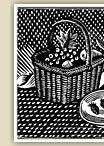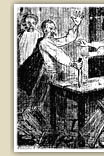|
|
 |
 |
 |
 |
 |
 |
 |
 |
 |
 |
|
In the beginning of this period, artists continued to work as wood-cutters, often
copying models furnished by wood engravings books, for newspapers
and periodicals of the time.
|

Nikolaos Pherbos taught copper-engraving and wood-cutting techniques in the School of Arts until 1915, when
classes ceased for financial reasons. The Royal Lithographers continued in operation, as did
other lithographers, who produced well known popular engravings.
The art of lithography expanded and Athenian newspapers published colour
and black and white lithographic cartoons, while as early as 1880 small lithographic firms printed commercial labels, military maps and so on with the autotype method (a photomechanical
method of printing that used a grid). A little later zincography and later still photozincography supplanted wood engraving in the illustrations
of printed material. Photozincographers, whose names appeared more and more often in printed material of the beginning of the
twentieth century, included El. Kazanis, Ar. Laios, Th. Molianos and Fr. Printezis. Later, in the inter-war period,
zincography and photozincography were industrialized; plates were manufactured in established zincographers and photozincographers that have been preserved to our own day, such as those of Evangelos Halkiopoulos and Ioannis Mangouzos.
Popular pictures, which reached their heyday during the Balkan Wars, were an important means
of information but also of ideological manipulation during this period. They served as artistic
war 'communiques'. They were sometimes accompanied by explanatory texts and aimed to boost morale (which had sunk after the 1897 defeat), to inspire the national spirit and the Great Idea. The fact that most pictures
of the time came from the Drakos Papadimitriou publishing house,
which was linked with the Lithographers of the Royal Court, G. Stangel & Sas, and bore the royal
coat of arms, betrays the extent of their relation to state propaganda.
|
 |

The frequent representation of the princes including the Crown Prince,
and their connection to the glamour of military triumphs enhanced pro-dynastic
feelings, especially after the criticism launched against them because of the 1897
defeat, according to which they were held responsible for national decline.
In the beginning of the twentieth century a change can be observed in the art of engraving in that it develops away from the secondary
role it had hitherto held to an autonomous and significant art form, capable of
expressing the preoccupations of artists and giving form to modern life. All its techniques develop,
and teachers appear now for the first time: Yannis Kefalinos held a prominent place among them. With their work engraving became independent, formulated its own values, characteristics, techniques and rules, while at the same time leaving great variety of choice vis-a-vis Realism or abstraction, black and white or colour, technique (wood-cutting, copper-engraving, lithography) and methodology. Among the prominent artits who emerged for the first time at the end of this period (and who would accomplish
the bulk of their work in the subsequent period) are Dimitrios Galanis, Angelos Theodoropoulos, Markos Zavitsianos,
Lykourgos Kogevinas, Yorgos Oikonomidis and, naturally, the great teacher of modern Greek engraving,
Yannis Kefalinos.
|
 |
 |
|
